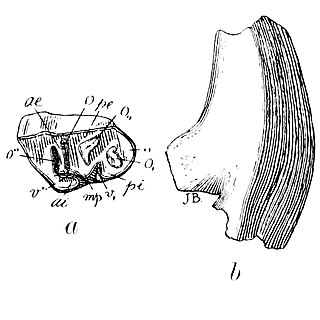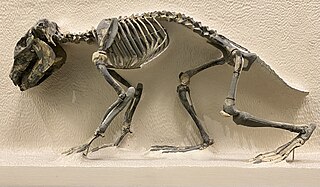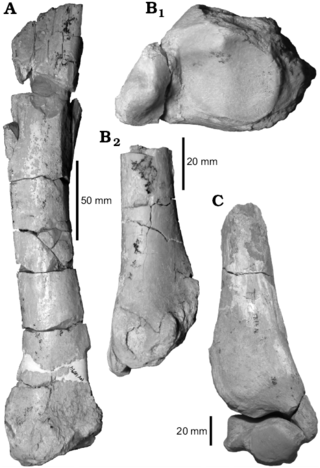
Cramauchenia is an extinct genus of litoptern South American ungulate. Cramauchenia was named by Florentino Ameghino. The name has no literal translation. Instead, it is an anagram of the name of a related genus Macrauchenia. This genus was initially discovered in the Sarmiento Formation in the Chubut Province, in Argentina, and later it was found in the Chichinales Formation in the Río Negro Province and the Cerro Bandera Formation in Neuquén, also in Argentina, in sediments assigned to the SALMA Colhuehuapian, as well as the Agua de la Piedra Formation in Mendoza, in sediments dated to the Deseadan. In 1981 Soria made C. insolita a junior synonym of C. normalis. A specimen of C. normalis was described in 2010 from Cabeza Blanca in the Sarmiento Formation, in sediments assigned to the Deseadan SALMA.

Interatherium is an extinct genus of interatheriid notoungulate from the Early to Middle Miocene (Colhuehuapian-Mayoan). Fossils have been found in the Santa Cruz, Collón Curá and Sarmiento Formations in Argentina.

Huilatherium is an extinct genus of leontiniid, a group of hoofed mammals belonging to the order Notoungulata, that comprises other South American ungulate families that evolved in parallel with some mammals of the Northern hemisphere. The leontiinids were a family of herbivorous species comprising medium to large browsers, with relatively short skulls and robust limbs, somewhat similar to their relatives, the best known toxodontids.
Patagorhacos is an extinct genus of medium-sized phorusrhacid from the early Miocene of Patagonia. Currently only the single species Patagorhacos terrificus is known, which is represented by two highly fragmentary specimen, one belonging to the back of the skull and the other being the distal end of a leg bone. It was described together with the contemporary rheid Opisthodactylus horacioperezi.
Eohyrax is an extinct genus of Notoungulate, belonging to the suborder Typotheria. It lived during the Middle Eocene, and its remains were discovered in South America.

Argyrohippus is an extinct genus of notoungulate, belonging to the family Notohippidae. It lived from the Late Oligocene to the Early Miocene, and its fossilized remains were found in South America.

Propachyrucos is an extinct genus of hegetotheriid notoungulate. It lived from the Late Oligocene to the Early Miocene, in what is today South America.

Gualta is an extinct genus of leontiniid notoungulates. It lived during the Late Oligocene of what is now Argentina.

Trachytherus is an extinct genus of mesotheriid notoungulate that lived from the Late Oligocene to the Early Miocene in what is now South America.

Pseudotypotherium is an extinct genus of Notoungulates, belonging to the suborder Typotheria. It lived from the Late Miocene to the Late Pliocene, and its fossilized remains were discovered in South America.

Eomorphippus is an extinct genus of notohippid notoungulate that lived from the Late Eocene to the Early Oligocene in what is today South America.
Anayatherium is an extinct genus of notoungulate belonging to the family Leontiniidae. It lived during the Late Oligocene, and its fossilized remains were discovered in South America.
Ancylocoelus is an extinct genus of mammal, belonging to the order Notoungulata. It lived during the Late Oligocene, in what is today Argentina, in South America.
Martinmiguelia is an extinct genus of Notoungulate, belonging to the family Leontiniidae. It lived during the Middle Eocene, and its fossil remains were found in South America.
Archaeopithecus is an extinct genus of notoungulate, belonging to the suborder Typotheria. It lived during the Middle Eocene, in what is today Argentina.
Oldfieldthomasia is an extinct genus of Notoungulate, probably related to the suborder Typotheria. It lived during the Middle Eocene, in what is today South America.
Patriarchus is an extinct genus of interatheriid notoungulates that lived during the Early Miocene in what is now Argentina. Fossils of this genus have been found in the Santa Cruz Formation of Argentina.

Cochilius is an extinct genus of interatheriid notoungulate that lived between the Late Oligocene and the lower Miocene in what is now Argentina.

Notopithecus is an extinct genus of Notoungulate, belonging to the suborder Typotheria. It lived from the Middle to the Late Eocene and its fossilized remains were discovered in South America.

Prozaedyus is an extinct genus of chlamyphorid armadillo that lived during the Middle Oligocene and Middle Miocene in what is now South America.




















